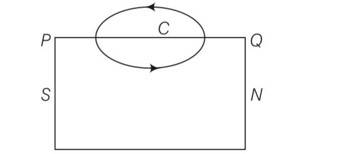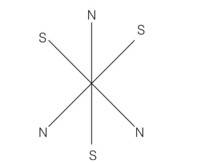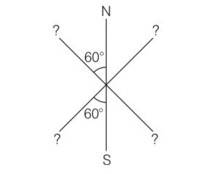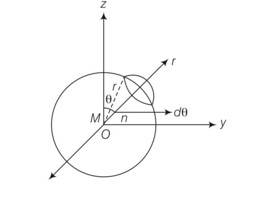Magnetism and Matter
Get insights from 91 questions on Magnetism and Matter, answered by students, alumni, and experts. You may also ask and answer any question you like about Magnetism and Matter
Follow Ask QuestionQuestions
Discussions
Active Users
Followers
New answer posted
5 months agoContributor-Level 10
This is a Multiple Choice Questions as classified in NCERT Exemplar
Answer- (c)
Explanation- magnetic field outside the toroid is inversely proportional to distance
New answer posted
5 months agoContributor-Level 10
This is a Short Answer Type Questions as classified in NCERT Exemplar
Explanation- in the given figure let C be the amperian loop then,

= .dl
between B and dl is less than 90 degree so
= . dl>0
So magnetic field from south pole to north pole inside the bar magnet
So according to ampere law
=0
= + = 0
>0, so <0,
It will be so if the angle between H and dl is more than 90 degree so cos is negative . it means H must run from north to south pole .
New answer posted
5 months agoContributor-Level 10
This is a Short Answer Type Question as classified in NCERT Exemplar
Explanation- I= moment of inertia of the bar magnet
m= mass of bar magnet
l= length of magnet about an any passing through its centre and perpendicular to its
length
M= magnetic moment of the magnet
B= uniform magnetic field in which magnet Is oscillating
T= 2
I= ml2/12
When magnet is cut into two equal pieces
I1= = ml2/96= I/8
Magnetic dipole moment M'= M/2
Its time period oscillation is T'= 2 = 2 =
New answer posted
5 months agoContributor-Level 10
This is a Short Answer Type Question as classified in NCERT Exemplar
Explanation-
From these two we can say that
=
pE= MB
E=cB
pcB=MB
p=M/c
New answer posted
5 months agoContributor-Level 10
This is a Short Answer Type Questions as classified in NCERT Exemplar
Explanation- I= moment of inertia of the bar magnet
m= mass of bar magnet
l= length of magnet about an any passing through its centre and perpendicular to its
length
M= magnetic moment of the magnet
B= uniform magnetic field in which magnet Is oscillating
T= 2
I= ml2/12
When magnet is cut into two equal pieces
I1= = ml2/96= I/8
Magnetic dipole moment M'= M/2
Its time period oscillation is T'= 2 = 2 =
T'=T/2
New answer posted
5 months agoContributor-Level 10
This is a Short Answer Type Questions as classified in NCERT Exemplar
Explanation-
From these two we can say that
=
pE= MB
E=cB
pcB=MB
p=M/c
New answer posted
5 months agoContributor-Level 10
This is a Short Answer Type Questions as classified in NCERT Exemplar
Explanation- the system will be in stable equilibrium if the net force on the system is zero and net torque on the system is also zero.

New answer posted
5 months agoContributor-Level 10
This is a Short Answer Type Questions as classified in NCERT Exemplar
Explanation- magnetic moment of dipole at origin o is
M=Mk
Magnetic field induction at p due to dipole moment
B= r
dS= r(rsin )r = (r2 sind )
= r(r2sin )
{cos4 }
(1-1)= 0
New answer posted
5 months agoContributor-Level 10
Explanation- When a diamagnetic material is dipped in liquid nitrogen, it again behaves as a diamagnetic material. Thus, superconducting material will again behave as a diamagnetic material. When this diamagnetic material is placed near a bar magnet, it will be feebly magnetised opposite to the direction of magnetising field.
(i) Thus, it will be repelled.
(ii) Also its direction of magnetic moment will be opposite to the direction of magnetic field of magnet.
New answer posted
5 months agoContributor-Level 10
This is a Short Answer Type Questions as classified in NCERT Exemplar
Explanation - = I/H
Diamagnetism is due to orbital motion of electrons in an atom developing magnetic moments opposite to applied field. Thus, the resultant magnetic moment of the diamagnetic material is zero and hence, the susceptibility χ of diamagnetic material is not much affected by temperature.
Paramagnetism and ferromagnetism is due to alignments of atomic magnetic moments in the direction of the applied field. As temperature is raised, the alignment is disturbed, resulting decrease in susceptibility of both with increase in temperature.
Taking an Exam? Selecting a College?
Get authentic answers from experts, students and alumni that you won't find anywhere else
Sign Up on ShikshaOn Shiksha, get access to
- 65k Colleges
- 1.2k Exams
- 679k Reviews
- 1800k Answers


